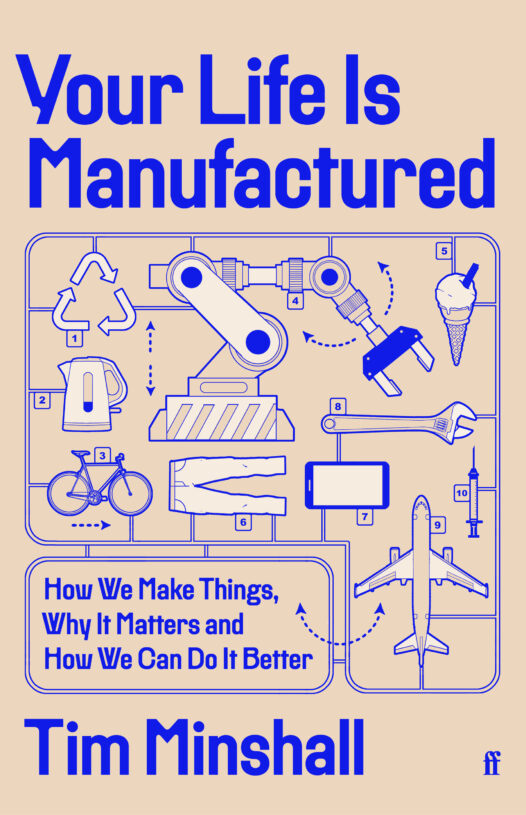“Unless you are currently floating naked through space, you are right now in immediate contact with multiple manufactured products. Throughout every day of your life you will be wearing, consuming, being transported or sheltered by, communicating through or being restored to health by manufactured products. Yet the processes by which these items appear in our lives are, to most of us, largely invisible.”
This is how Tim Minshall, Professor of Innovation and Head of Institute for Manufacturing, University of Cambridge, starts his book ‘Your Life is Manufactured’ inspired in part by an invitation to talk to pre-teens about the role of manufacturing.
He realised that for these students that world is increasingly virtual with services and products appearing magically to their doorstep on demand.
So he looked for ways to make it tangible and important to them and he has captured some of his thinking in this very readable book.

Does manufacturing have the answer to sustainability?
The manufacturing world was largely invisible, until in 2020 it all stopped. With even basic products like toilet roll, tissues, and yeast suddenly absent from the supermarkets, the words ‘supply’, ‘chain’ and ‘resilience’ became part of the news agenda.
Although written with humour, the book covers the key concepts of how manufacturing works at the moment and the way this is being disrupted by emerging technologies.
The book also takes the reader further to consider manufacturing of the future. Tim asks the big questions: “Why is our modern manufacturing world so fragile and so damaging to the planet? And what can be done to make it less fragile and damaging?” and gives examples of how innovation in supply chain management, business models and technologies can offer solutions.
Fulfilling Maslow’s hierarchy of needs is putting our future at risk
It was American psychologist Abraham Maslow who first proposed a ‘hierarchy of needs’ – the basic physiological needs that need to satisfied before worrying about the higher needs.
Unfortunately, as Tim outlines, fulfilling those basic needs is putting our future survival in jeopardy. He explains how huge inefficiencies in each of the ‘make, move and consume’ stages of the manufacturing process are not sustainable, but then reveals how looking at issues from a different perspective can address these challenges.
Shelter
Cement manufacture has transformed lives – covering dirt floors and tracks with cement has reduced the transmission of parasitic disease, improved livelihoods and enabled more children to go to school. Yet, is the most carbon-intensive and environmentally damaging of all building materials. Four billion tonnes are produced each year, contributing 8% of total global CO2 emissions – four times that of aviation.
More efficient cement production: alternative methods of production and ways to recycle cement are currently under development, which will make a radical change, but incremental process improvements that can reduce energy consumption promises impact in the near future.
For example, early-stage UK company Carbon Re has used AI to model cement production and optimise it, reducing fuel costs by 10% and carbon emissions by 20%. With over three thousand cement factories worldwide even a 1% reduction in energy consumption could save 45 million tonnes of CO2.
Food
We produce enough food to feed all the eight billion people in the world – in fact we are producing enough to feed ten billion, but one in nine people is undernourished as our manufacturing system wastes 40% of the food it produces; 10% of all emissions are generated producing food that is never eaten.
Food manufacturing re-imagined: Tim gives the British Sugar plant at Wissington, UK as an example of how a factory can be engineered to eliminate all waste. The root vegetable sugar beet is processed to produce raw sugar – the by-products are fermented to generate bioethanol, a biofuel and additive for petrol.
Electricity created to extract the sugar is generated by Anaerobic Digestion (AD) of by-products, the excess power (up to 5MW) is exported to the National Grid as clean renewable electricity. Any surplus heat and CO2 is pumped into eighteen hectares of glasshouses and used to ripen tomatoes.
Clothing
60 million people worldwide are involved in clothing production – with worldwide sales estimated to be $2.4 trillion – but over one-third of raw materials in the textile supply chain go to waste before a garment reaches the consumer, with over-production running at 10-40% each year. It is also responsible for 20% of all water pollution.
Alternative jean manufacture reduces water consumption: more glimpses of hope are given with the case-study of Jeanologia, which uses ozone instead of chemical bleaching to fade jeans, a ‘nano-bubble’ system to soften them (reducing water consumption by 90%) and a cool laser technology to create a bespoke vintage look without energy intensive sand blasting. It estimates that these new technologies are now used in the manufacture of a third, of the five billion, jeans produced each year.
Renovate, Repair, Rethink
Tim argues that manufacturing must help us thrive, not just survive: “If we want to transform our food and healthcare system a whole host of new things need to be dreamed up and produced at scale.
“Although remarkable in many ways, our global manufacturing system is making a negative contribution to the health of the planet and its population.
“Operational changes – such as moving from the linear ‘extract-make-use-dispose’ to the circular ‘reduce-reuse-recycle’ provides a great template for this redesign. But could we go further and, like the natural world, become regenerative?”
Manufacturing is the solution
He makes the point that a vigorous, resourceful manufacturing sector is vital to economic success and should be at the heart of the economy, quoting Jeremy Farrar, former head of the Wellcome Trust, who comments that the ability to respond to crisis depends on the the people, infrastructure and trust that you have in place before it happens.
Tim gives the example of technologies to mitigate the damage done and those that enable us to adapt to the problems created – rising sea-levels, drought, forest fires, expanding this to say it will be possible, with vision, to transition the manufacturing world through being ‘less bad’ to ‘making things better’.
“To really make a difference, we are going to need the most skilled people, the wisest investors, the most visionary politicians and the most scale-up-focused entrepreneurs targeting all their efforts on transforming our manufacturing systems,” he says.
“As I hope you can see from what we’ve covered in this book, this is now happening – we just need it to happen a lot faster, and at much greater scale.”
‘Your Life Is Manufactured: How We Make Things, Why It Matters and How We Can Do It Better’ by Tim Minshall, published in Hardcover on 13 Feb. 2025


